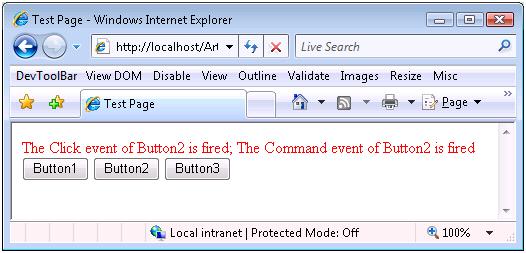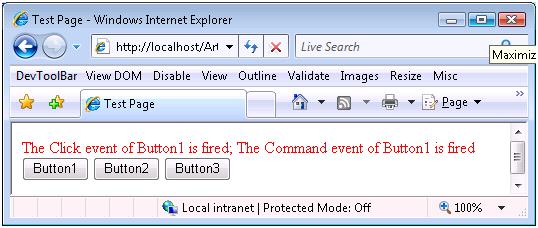浅谈ASP.NET的Postback
说道ASP.NET的Postback,就得说Web Page的生命周期,但是Web Page的生命周期却不是三言两语就能够说得清楚的,所以在这里单纯站的编程的角度,撇开Web Page 的生命周期浅谈Postback。
我们知道,无论是ASP.NET1.x,2.0,甚至是以后的版本,ASP.NET最终Render到Client端通过浏览器浏览的都是一样:一个单纯的HTML。Client通过Submit Form的方式将填入Form的数据提交给Server进行处理。我们现在来看看ASP.NET整个Postback程序处理的过程。
首先我们通过一个Sample来看ASP.NET如何处理一个通过Click一个Button引起的Postback。下面是Web Page的HTML:
 <%@ Page Language="C#" AutoEventWireup="true" CodeFile="Default.aspx.cs" Inherits="_Default" %>
<%@ Page Language="C#" AutoEventWireup="true" CodeFile="Default.aspx.cs" Inherits="_Default" %> <!DOCTYPE html PUBLIC "-//W3C//DTD XHTML 1.0 Transitional//EN" "http://www.w3.org/TR/xhtml1/DTD/xhtml1-transitional.dtd">
<!DOCTYPE html PUBLIC "-//W3C//DTD XHTML 1.0 Transitional//EN" "http://www.w3.org/TR/xhtml1/DTD/xhtml1-transitional.dtd"> <html xmlns="http://www.w3.org/1999/xhtml">
<html xmlns="http://www.w3.org/1999/xhtml"> <head runat="server">
<head runat="server"> <title>Test Page</title>
<title>Test Page</title> </head>
</head> <body>
<body> <form id="form1" runat="server">
<form id="form1" runat="server"> <div>
<div> <asp:Label runat="server" ID="LabelMessage" ForeColor="red"></asp:Label>
<asp:Label runat="server" ID="LabelMessage" ForeColor="red"></asp:Label> </div>
</div> <div>
<div> <asp:Button runat="server" ID="Button1" Text="Button1" OnClick="Button1_Click" OnCommand="Button_Command" CommandArgument="Button1" />
<asp:Button runat="server" ID="Button1" Text="Button1" OnClick="Button1_Click" OnCommand="Button_Command" CommandArgument="Button1" /> <asp:Button runat="server" ID="Button2" Text="Button2" OnClick="Button2_Click" OnCommand="Button_Command" CommandArgument="Button2" UseSubmitBehavior="false" />
<asp:Button runat="server" ID="Button2" Text="Button2" OnClick="Button2_Click" OnCommand="Button_Command" CommandArgument="Button2" UseSubmitBehavior="false" /> <asp:Button runat="server" ID="Button3" Text="Button3" OnClick="Button3_Click" OnCommand="Button_Command" CommandArgument="Button3" UseSubmitBehavior="false" />
<asp:Button runat="server" ID="Button3" Text="Button3" OnClick="Button3_Click" OnCommand="Button_Command" CommandArgument="Button3" UseSubmitBehavior="false" /> </div>
</div> </form>
</form> </body>
</body> </html>
</html>
很简单,定义了3个Button,分别注册了他们的两个Event:Click和Command。3个Button的Command Event Hander是一样的:Button_Command,通过指定的CommandArgument来让Event Handler判断到底是哪个Button触发了Command Event。
下面是Code Behind:
 using System;
using System; using System.Data;
using System.Data; using System.Configuration;
using System.Configuration; using System.Web;
using System.Web; using System.Web.Security;
using System.Web.Security; using System.Web.UI;
using System.Web.UI; using System.Web.UI.WebControls;
using System.Web.UI.WebControls; using System.Web.UI.WebControls.WebParts;
using System.Web.UI.WebControls.WebParts; using System.Web.UI.HtmlControls;
using System.Web.UI.HtmlControls;
 public partial class _Default : System.Web.UI.Page
public partial class _Default : System.Web.UI.Page {
{ 
 protected void Page_Load(object sender, EventArgs e)
protected void Page_Load(object sender, EventArgs e) {
{
 }
} protected void Button1_Click(object sender, EventArgs e)
protected void Button1_Click(object sender, EventArgs e) {
{ string message = string.Format("The {0} event of {1} is fired", "Click", "Button1");
string message = string.Format("The {0} event of {1} is fired", "Click", "Button1"); this.LabelMessage.Text = message;
this.LabelMessage.Text = message; }
} protected void Button2_Click(object sender, EventArgs e)
protected void Button2_Click(object sender, EventArgs e) {
{ string message = string.Format("The {0} event of {1} is fired", "Click", "Button2");
string message = string.Format("The {0} event of {1} is fired", "Click", "Button2"); this.LabelMessage.Text = message;
this.LabelMessage.Text = message; }
} protected void Button3_Click(object sender, EventArgs e)
protected void Button3_Click(object sender, EventArgs e) {
{ string message = string.Format("The {0} event of {1} is fired", "Click", "Button3");
string message = string.Format("The {0} event of {1} is fired", "Click", "Button3"); this.LabelMessage.Text = message;
this.LabelMessage.Text = message; }
}
 protected void Button_Command(object sender, CommandEventArgs e)
protected void Button_Command(object sender, CommandEventArgs e) {
{ string message = string.Format("The {0} event of {1} is fired", "Command", e.CommandArgument);
string message = string.Format("The {0} event of {1} is fired", "Command", e.CommandArgument); this.LabelMessage.Text += "; " + message;
this.LabelMessage.Text += "; " + message; }
} }
}
我们来运行这个Page,并Click某个按钮(比如Button2):

我们通过最上方的Message可以看出,Button2的Click Event和Command先后触发。
这篇Blog的主旨就是从方法调用的角度讲述整个程序运行的过程:从HTML 被Render到Client端,到用户Click某个按钮,输入被Postback到Server端,并触发两个Event,执行Event Handler打印出相关的Message。
首先我们来看看ASP.NET设计的Page Render到Client端的HTML是什么样子:
 <!DOCTYPE html PUBLIC "-//W3C//DTD XHTML 1.0 Transitional//EN" "http://www.w3.org/TR/xhtml1/DTD/xhtml1-transitional.dtd">
<!DOCTYPE html PUBLIC "-//W3C//DTD XHTML 1.0 Transitional//EN" "http://www.w3.org/TR/xhtml1/DTD/xhtml1-transitional.dtd"> <html xmlns="http://www.w3.org/1999/xhtml">
<html xmlns="http://www.w3.org/1999/xhtml"> <head>
<head> <title>
<title> Test Page
Test Page </title>
</title> </head>
</head> <body>
<body> <form name="form1" method="post" action="Default.aspx" id="form1">
<form name="form1" method="post" action="Default.aspx" id="form1"> <div>
<div> <input type="hidden" name="__EVENTTARGET" id="__EVENTTARGET" value="" />
<input type="hidden" name="__EVENTTARGET" id="__EVENTTARGET" value="" /> <input type="hidden" name="__EVENTARGUMENT" id="__EVENTARGUMENT" value="" />
<input type="hidden" name="__EVENTARGUMENT" id="__EVENTARGUMENT" value="" /> <input type="hidden" name="__VIEWSTATE" id="__VIEWSTATE" value="/wEPDwUKMTA0NDQ2OTE5OWRk281L4eAk7iZT10hzg+BeOyoUWBQ=" />
<input type="hidden" name="__VIEWSTATE" id="__VIEWSTATE" value="/wEPDwUKMTA0NDQ2OTE5OWRk281L4eAk7iZT10hzg+BeOyoUWBQ=" /> </div>
</div>
 <script type="text/javascript">
<script type="text/javascript"> <!--
<!-- var theForm = document.forms['form1'];
var theForm = document.forms['form1']; if (!theForm) {
if (!theForm) { theForm = document.form1;
theForm = document.form1; }
} function __doPostBack(eventTarget, eventArgument) {
function __doPostBack(eventTarget, eventArgument) { if (!theForm.onsubmit || (theForm.onsubmit() != false)) {
if (!theForm.onsubmit || (theForm.onsubmit() != false)) { theForm.__EVENTTARGET.value = eventTarget;
theForm.__EVENTTARGET.value = eventTarget; theForm.__EVENTARGUMENT.value = eventArgument;
theForm.__EVENTARGUMENT.value = eventArgument; theForm.submit();
theForm.submit(); }
} }
} // -->
// --> </script>
</script>
 <div>
<div> <span id="LabelMessage" style="color:Red;"></span>
<span id="LabelMessage" style="color:Red;"></span> </div>
</div> <div>
<div> <input type="submit" name="Button1" value="Button1" id="Button1" />
<input type="submit" name="Button1" value="Button1" id="Button1" /> <input type="button" name="Button2" value="Button2" onclick="javascript:__doPostBack('Button2','')" id="Button2" />
<input type="button" name="Button2" value="Button2" onclick="javascript:__doPostBack('Button2','')" id="Button2" /> <input type="button" name="Button3" value="Button3" onclick="javascript:__doPostBack('Button3','')" id="Button3" />
<input type="button" name="Button3" value="Button3" onclick="javascript:__doPostBack('Button3','')" id="Button3" /> </div>
</div> </form>
</form> </body>
</body> </html>
</html>
上面的HTMLBody部分大体包括3个部分:
1. 定义了3个hidden field:
 <input type="hidden" name="__EVENTTARGET" id="__EVENTTARGET" value="" />
<input type="hidden" name="__EVENTTARGET" id="__EVENTTARGET" value="" />  <input type="hidden" name="__EVENTARGUMENT" id="__EVENTARGUMENT" value="" />
<input type="hidden" name="__EVENTARGUMENT" id="__EVENTARGUMENT" value="" /> <input type="hidden" name="__VIEWSTATE" id="__VIEWSTATE" value="/wEPDwUKMTA0NDQ2OTE5OWRk281L4eAk7iZT10hzg+BeOyoUWBQ=" />
<input type="hidden" name="__VIEWSTATE" id="__VIEWSTATE" value="/wEPDwUKMTA0NDQ2OTE5OWRk281L4eAk7iZT10hzg+BeOyoUWBQ=" />
从他们的命名可以看出他们分别代表的意思:__EVENTTARGET代表触发Event的Control的Unique name;__EVENTARGUMENT代表为Event Handler定义的额外的参数;__VIEWSTATE:代表的是Viewstate。
2. 一段script:
 <script type="text/javascript">
<script type="text/javascript"> <!--
<!-- var theForm = document.forms['form1'];
var theForm = document.forms['form1']; if (!theForm) {
if (!theForm) { theForm = document.form1;
theForm = document.form1; }
} function __doPostBack(eventTarget, eventArgument) {
function __doPostBack(eventTarget, eventArgument) { if (!theForm.onsubmit || (theForm.onsubmit() != false)) {
if (!theForm.onsubmit || (theForm.onsubmit() != false)) { theForm.__EVENTTARGET.value = eventTarget;
theForm.__EVENTTARGET.value = eventTarget; theForm.__EVENTARGUMENT.value = eventArgument;
theForm.__EVENTARGUMENT.value = eventArgument; theForm.submit();
theForm.submit(); }
} }
} // -->
// --> </script>
</script>
定义了一个__doPostBack function完成Postback的操作,该function只有区区3行代码,前两行通过参数对上面定义的两个hidden field赋值,然后向Server端提交表单。
3. 一段HTML对应通过ASP.NET定义的Web Control。
 <div>
<div> <span id="LabelMessage" style="color:Red;"></span>
<span id="LabelMessage" style="color:Red;"></span> </div>
</div> <div>
<div> <input type="submit" name="Button1" value="Button1" id="Button1" />
<input type="submit" name="Button1" value="Button1" id="Button1" /> <input type="button" name="Button2" value="Button2" onclick="javascript:__doPostBack('Button2','')" id="Button2" />
<input type="button" name="Button2" value="Button2" onclick="javascript:__doPostBack('Button2','')" id="Button2" /> <input type="button" name="Button3" value="Button3" onclick="javascript:__doPostBack('Button3','')" id="Button3" />
<input type="button" name="Button3" value="Button3" onclick="javascript:__doPostBack('Button3','')" id="Button3" /> div>
div>
我们定义的3个Button被转化成3个能向Server端提交表单的<input > Tag, 但是他们提交表的方式却不一样,第一个以<input type="submit">的方式提交,后面两个通过调用javascript的方式提交表单(<input type="button">)。对于一个System.Web.UI.WebControls.Button,默认采用第一种提交方式,但是我们通过设置UseSubmitBehavior属性(这个属性时ASP.NET 2.0新加的,1x没有相应的设置),改变其表单提交的行为。
当用户Click Button2的时候,调用__doPostBack,并传入两个参数:一个代表出发Event的对象的Unique name,也就是Button2的名称,另一个描述Event的额外信息的参数,这里不需要,所以这里是空字符串。在__doPostBack中把这两个参数赋值给两个Hidden Field:__EVENTTARGET,__EVENTARGUMENT。然后向Server端提交表单,完成Postback。
然后我们来看看Server如何处理这个Postback,关于Web Page的生命周期在这里就不详细介绍了。Server端通过__EVENTTARGET这个hidden field的值找到对应的Server端的Control,通过Reflection确定该Control是否实现了System.Web.UI.IPostBackEventHandler Interface。如果该Control确实实现了该Interface,那么调用Page的RaisePostBackEvent方法,这是一个Virtual的方法,可以被Override。我们来看该方法的定义。
 [EditorBrowsable(EditorBrowsableState.Advanced)]
[EditorBrowsable(EditorBrowsableState.Advanced)] protected virtual void RaisePostBackEvent(IPostBackEventHandler sourceControl, string eventArgument)
protected virtual void RaisePostBackEvent(IPostBackEventHandler sourceControl, string eventArgument) {
{ sourceControl.RaisePostBackEvent(eventArgument);
sourceControl.RaisePostBackEvent(eventArgument); }
}
我们可以看到该方法直接调用该sourceControl的RaisePostBackEvent,并传入一个eventArgument参数,在这个例子中sourceControl就是__EVENTTARGET对应的Web Control:Button2,eventArgument就是__EVENTTARGET对应的值:一个空字符串。Button2的类型是System.Web.UI.WebControls.Button。我们来看看System.Web.UI.WebControls.Button中的RaisePostBackEvent方法是如何定义的:
 protected virtual void RaisePostBackEvent(string eventArgument)
protected virtual void RaisePostBackEvent(string eventArgument) {
{ base.ValidateEvent(this.UniqueID, eventArgument);
base.ValidateEvent(this.UniqueID, eventArgument); if (this.CausesValidation)
if (this.CausesValidation) {
{ this.Page.Validate(this.ValidationGroup);
this.Page.Validate(this.ValidationGroup); }
} this.OnClick(EventArgs.Empty);
this.OnClick(EventArgs.Empty); this.OnCommand(new CommandEventArgs(this.CommandName, this.CommandArgument));
this.OnCommand(new CommandEventArgs(this.CommandName, this.CommandArgument)); }
}
这个方法也很简单,先进行Validation,然后先后出发两个Event:OnClick 和OnCommand,随后调用对应的Event handler,这和我们的输出结果是吻合的。
这基本上就是整个Postback的整个程序执行的过程,现在我们对我们的Page作一些小的有趣的改动,来验证一下:
Client端和Server端进行交互的途径就是提交表单(Form Submitting),而我们现在有两种方式来提交表单:通过<input type="submit">控件;通过调用javascript:__doPostBack。基于这一点我们在Html中加了下面一段javascript:
 <script type="text/javascript">
<script type="text/javascript"> function postback()
function postback() {
{
 __doPostBack('Button1','');
__doPostBack('Button1',''); }
} 
 document.getElementById("Button2").onclick = postback;
document.getElementById("Button2").onclick = postback; document.getElementById("Button3").onclick = postback;
document.getElementById("Button3").onclick = postback;  </script>
</script>
我们override Button2和Button3的onclick event,把'Button1作为参数传入__doPostBack方法,可以想象,现在无论Click那个Button,程序都将认为之Click Button1。有兴趣的可以亲自试试,无论Click那个Button,显示的效果都将是下面的样子:

接下来我们取消上面的改动,在Server对Code作另一方面的尝试。我们前面说过,Server接受到Client的Postback,对于事件的Web Control(或者Html Server Control),如果实现了System.Web.UI.IPostBackEventHandler接口,会调用Page的virtual方法:RaisePostbackEvent,我们现在来Override这个方法:
 protected override void RaisePostBackEvent(IPostBackEventHandler sourceControl, string eventArgument)
protected override void RaisePostBackEvent(IPostBackEventHandler sourceControl, string eventArgument) {
{ sourceControl = this.Button1;
sourceControl = this.Button1; base.RaisePostBackEvent(sourceControl, eventArgument);
base.RaisePostBackEvent(sourceControl, eventArgument); }
}
在上面的Code中,我们把sourceControl设为Button1,这样无论在client端Click的那个Button,现在都将认为是对Button的Click。运行的结果和上面一样。
通过上面的介绍,我们知道了Page的RaisePostBackEvent会调用Source Control的RaisePostBackEvent方法,这个方法是定义在IPostBackEventHandler接口中,很多Control都实现了这个方法,对于Button来说,这个方法是Virtual的,它可以被你Override,如果感兴趣的话,可以自己写一个Custom Button,并Override该方法,看看执行的情况,相信会使加深你对Postback的理解。
浅谈ASP.NET的Postback的更多相关文章
- 【ASP.NET MVC系列】浅谈ASP.NET MVC八大类扩展(上篇)
lASP.NET MVC系列文章 [01]浅谈Google Chrome浏览器(理论篇) [02]浅谈Google Chrome浏览器(操作篇)(上) [03]浅谈Google Chrome浏览器(操 ...
- 【ASP.NET MVC系列】浅谈ASP.NET 页面之间传值的几种方式
ASP.NET MVC系列文章 [01]浅谈Google Chrome浏览器(理论篇) [02]浅谈Google Chrome浏览器(操作篇)(上) [03]浅谈Google Chrome浏览器(操作 ...
- 【ASP.NET MVC系列】浅谈ASP.NET MVC运行过程
ASP.NET MVC系列文章 [01]浅谈Google Chrome浏览器(理论篇) [02]浅谈Google Chrome浏览器(操作篇)(上) [03]浅谈Google Chrome浏览器(操作 ...
- 【ASP.NET MVC系列】浅谈ASP.NET MVC 视图
ASP.NET MVC系列文章 [01]浅谈Google Chrome浏览器(理论篇) [02]浅谈Google Chrome浏览器(操作篇)(上) [03]浅谈Google Chrome浏览器(操作 ...
- 【ASP.NET MVC系列】浅谈ASP.NET MVC 视图与控制器传递数据
ASP.NET MVC系列文章 [01]浅谈Google Chrome浏览器(理论篇) [02]浅谈Google Chrome浏览器(操作篇)(上) [03]浅谈Google Chrome浏览器(操作 ...
- 【ASP.NET MVC系列】浅谈ASP.NET MVC 控制器
ASP.NET MVC系列文章 [01]浅谈Google Chrome浏览器(理论篇) [02]浅谈Google Chrome浏览器(操作篇)(上) [03]浅谈Google Chrome浏览器(操作 ...
- 【ASP.NET MVC系列】浅谈ASP.NET MVC 路由
ASP.NET MVC系列文章 [01]浅谈Google Chrome浏览器(理论篇) [02]浅谈Google Chrome浏览器(操作篇)(上) [03]浅谈Google Chrome浏览器(操作 ...
- 【ASP.NET MVC系列】浅谈ASP.NET 程序发布过程
ASP.NET MVC系列文章 [01]浅谈Google Chrome浏览器(理论篇) [02]浅谈Google Chrome浏览器(操作篇)(上) [03]浅谈Google Chrome浏览器(操作 ...
- 浅谈ASP.NET ---- 系列文章
[01]浅谈Google Chrome浏览器(理论篇) [02]浅谈Google Chrome浏览器(操作篇)(上) [03]浅谈Google Chrome浏览器(操作篇)(下) [04]浅谈ASP. ...
随机推荐
- bzoj 1875 矩阵快速幂
思路:不能走走过来的路,变点交换跑矩阵快速幂. #include<bits/stdc++.h> #define LL long long #define fi first #define ...
- Map 的四种遍历方式
Map 的四种遍历方式 import java.util.HashMap; import java.util.Iterator; import java.util.Map; public class ...
- webpack 入门总结和实践(按需异步加载,css单独打包,生成多个入口文件)
为什么是webpack webpack一下自己就
- fastadmin: layer.open 弹出层如何在表单提交之后自动关闭?
需要在控制器对应的js文件中添加 Form.api.bindevent($("form[role=form]")); define(['jquery', 'bootstrap' ...
- 洛谷P1099 BZOJ1999 树网的核 [搜索,树的直径]
洛谷传送门,BZOJ传送门 树网的核 Description 设T=(V, E, W) 是一个无圈且连通的无向图(也称为无根树),每条边带有正整数的权,我们称T为树网(treenetwork),其中V ...
- Java常用工具类之删除文件
package com.wazn.learn.util; import java.io.File; /** * 删除文件工具类 * @author yangzhenyu * */ public cla ...
- 【JAVAWEB学习笔记】22_ajax:异步校验用户名和站内查询
Js原生Ajax和Jquery的Ajax 学习目标 案例1-异步校验用户名是否存在 案例2-站内查询 一.Ajax概述 1.什么是同步,什么是异步 同步现象:客户端发送请求到服务器端,当服务器返回响应 ...
- /.nav-tabs :是普通标签页 .nav-pills:胶囊式标签页 action ;默认的激活项,给<li>加默认显示的是哪个标签页内容 .nav是标签页的一个基类,给ul加 .nav-stacked: 垂直排列BootStrap
<meta name="viewport" content="with=device-width, initial-scale=1, user-scalabe=no ...
- herbinate 数据库乱码
改jdbc或者hibernate编码: jdbc:mysql://127.0.0.1:3306/db?useUnicode=true&characterEncoding=utf-8 ...
- CUDA学习笔记2:CUDA(英伟达显卡统一计算架构)与已有的VS项目结合
一.步骤 1.先新建一个简单的控制台应用程序,项目名称为Mytest,如下图所示: 2.在项目中添加一个名为Test.cu文件,如下图所示: 3.在解决方案资源管理器中选择该项目并点击右键,在弹出的菜 ...
